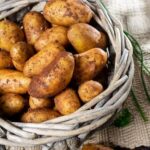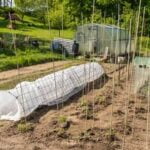Are you interested in planting vegetables in container gardens? Container gardening offers a convenient and flexible way to grow your favorite vegetables, even if you have limited space or access to a traditional garden plot. In this article, we will explore the world of planting vegetables in container gardens, highlighting the benefits and advantages of this popular gardening method.
Container gardening has become increasingly popular for many reasons. It allows individuals to grow their own vegetables without the need for a large yard or garden space.
Whether you live in an apartment, have a small outdoor patio, or simply want to add some greenery to your home, container gardening provides a practical solution for cultivating fresh produce. Additionally, container gardens can be moved around as needed to optimize sunlight exposure and adjust for weather conditions, making it easier to maintain and care for your vegetable plants.
In this comprehensive guide, we will provide valuable information on choosing the right containers, selecting suitable vegetables for container gardening, preparing the containers for planting, caring for vegetable plants in containers, and troubleshooting common issues related to this type of gardening. Whether you’re a novice gardener or an experienced enthusiast looking for new ideas, this article will help you get started or enhance your knowledge of growing delicious veggies in your own container garden.
Choosing the Right Containers
Container gardening is a great way to grow your own vegetables, especially for those with limited outdoor space or poor soil quality. When it comes to planting vegetables in container gardens, choosing the right containers is essential for the success of your garden. There are different types of containers suitable for vegetable gardening, and selecting the right size and material can make a significant difference in the growth and productivity of your plants.
One important consideration when choosing containers for planting vegetables is the size. Larger vegetables such as tomatoes, peppers, and eggplants require larger containers to accommodate their root systems and provide enough space for growth. On the other hand, smaller vegetables like lettuce, spinach, and herbs can thrive in smaller containers. It’s important to research the specific space requirements for each type of vegetable you plan to grow and choose the appropriate container size accordingly.
In addition to size, the material of the container also plays a crucial role in maintaining a healthy environment for your plants. Terracotta pots are popular for their classic look and good drainage, but they can dry out quickly and may require more frequent watering.
Plastic containers are lightweight and retain moisture better, making them ideal for plants that prefer consistent soil moisture. It’s essential to match the material of the container with the watering needs of the vegetables you intend to plant.
When considering materials, remember that vegetables planted in dark-colored containers may be more prone to overheating in hot weather compared to those planted in lighter-colored pots. Proper drainage is another important aspect to consider when choosing containers for planting vegetables. Without adequate drainage holes at the bottom of the container, excess water can pool around the roots of your plants, leading to root rot or other moisture-related issues.
| Types | Advantages |
|---|---|
| Terracotta Pots | Classic look; good drainage |
| Plastic Containers | Lightweight; retain moisture better |
| Fabric Grow Bags | Better air circulation; prevents overwatering |
Selecting the Best Vegetables
When it comes to planting vegetables in container gardens, choosing the right vegetables is crucial for a successful harvest. Not all vegetables are suitable for container gardening, so it’s important to make wise selections based on the available space, sunlight, and climate. With the right choices, you can enjoy a bountiful harvest of fresh produce right from your patio or balcony.
Best Vegetables for Container Gardening
Certain vegetables thrive in containers and are well-suited for small spaces. Some of the best vegetables for planting in container gardens include tomatoes, peppers, lettuce, spinach, radishes, carrots, and herbs like basil, thyme, and parsley. These veggies not only add beauty and greenery to your outdoor space but also provide you with an abundant supply of fresh produce throughout the growing season.
When selecting vegetables for your container garden, it’s essential to consider factors such as the size of the mature plant, the depth of the root system, and its sunlight requirements. Choose compact varieties or dwarf cultivars that are specifically bred for small spaces. Additionally, consider the climate in your area and select vegetables that are well-suited for your growing zone. By carefully considering these factors, you can ensure a thriving vegetable container garden that yields a plentiful harvest.
When planting vegetables in container gardens,you should also consider companion planting techniques that can maximize space and create a harmonious environment for your crops. Certain plants complement each other when grown together while deterring pests or improving soil fertility. By strategically selecting compatible plants for your container garden, you can increase your chances of success and enjoy a diverse range of homegrown produce.
Preparing the Container
When planting vegetables in container gardens, one of the most important steps is to properly prepare the containers for optimal plant growth. The first consideration when preparing the container is to ensure that it has proper drainage. Without adequate drainage, excess water can accumulate in the soil, leading to root rot and other issues. To facilitate drainage, drill several small holes in the bottom of the container if they are not already present.
Once you have addressed drainage, you’ll want to focus on soil preparation. Choose a high-quality potting mix specifically formulated for vegetable gardening. This type of soil ensures good aeration and water retention, both essential for healthy vegetable plants. Fill the container with the potting mix up to about an inch below the rim to allow space for watering without overflow.
In addition to proper drainage and soil preparation, it’s important to consider the size of the container when preparing it for planting vegetables. Larger containers generally provide more space for root growth and moisture retention, minimizing fluctuations in soil temperature and moisture levels. It’s also worth noting that certain vegetable plants require deeper containers than others – for example, root vegetables like carrots or potatoes ideally should be planted in deeper containers than leafy greens or herbs.
| Container Preparation Tips | Benefits |
|---|---|
| Drill small holes in the bottom of the container for proper drainage | Prevents waterlogging and root rot |
| Use high-quality potting mix formulated for vegetables | Ensures good aeration and water retention |
| Select appropriately sized containers according to the type of vegetable being planted | Optimizes space for root growth and moisture retention |
Planting and Caring for Vegetables
Planting vegetables in container gardens is a great way to enjoy homegrown produce, even if you don’t have a traditional garden space. Whether you have a small balcony, patio, or windowsill, container gardening can provide a bountiful harvest of fresh vegetables. In this section, we will provide detailed instructions on how to plant and care for vegetables in container gardens.
Planting Seeds or Seedlings
When planting vegetables in container gardens, it’s important to choose the right seeds or seedlings for your specific growing conditions. Consider the amount of sunlight your containers receive and the mature size of the plants. Some popular vegetables that thrive in containers include tomatoes, peppers, lettuce, radishes, and herbs like basil and parsley. When planting seeds or seedlings in your containers, follow these steps:
- Fill the container with well-draining potting soil
- Plant the seeds at the depth recommended on the seed packet or transplant seedlings with care
- Water the containers gently to avoid displacing the seeds or disturbing the roots of transplanted seedlings
Watering, Fertilizing, and Pest Control
Proper care and maintenance are crucial for the success of your vegetable container garden. Watering is essential to keep the soil consistently moist but not waterlogged. Consider using a watering can with a fine rose attachment to avoid splashing or overwatering.
Additionally, fertilize your container-grown vegetables with a balanced fertilizer according to package instructions to promote healthy growth and fruit production. Keep an eye out for common pests such as aphids, caterpillars, and spider mites that may affect your plants. Combat these pests using organic solutions like neem oil or insecticidal soap.
Maintaining Healthy Container Gardens
As your vegetable plants grow and produce crops, it’s essential to maintain their health and productivity. Regularly inspect your containers for signs of nutrient deficiencies, diseases, or pests and take appropriate action when necessary. Prune sprawling plants like tomatoes and peppers to maintain airflow and reduce the risk of disease. Consider rotating your containers occasionally to allow all sides of the plants equal access to sunlight for even growth.
By following these guidelines for planting seeds or seedlings in containers and providing proper care through watering, fertilizing, and pest control measures, you can enjoy a plentiful harvest from your vegetable container garden throughout the growing season.
Harvesting and Maintaining Container Gardens
Harvesting Vegetables From Containers
Once your vegetables have reached maturity, it’s time to harvest them from your container garden. The best way to determine if your vegetables are ready for harvesting is to follow the specific guidelines for each type of vegetable.
For example, tomatoes should be harvested when they are fully colored and firm to the touch, while leafy greens can be harvested as soon as they reach a size suitable for eating. Be sure to use sharp scissors or pruning shears to avoid damaging the rest of the plant.
Maintaining Container Gardens
To ensure continued productivity in your container garden, it’s important to practice regular maintenance. This includes monitoring for signs of pests or disease and promptly addressing any issues that arise. Regular watering is also essential, as container gardens can dry out more quickly than traditional gardens. Additionally, consider adding organic fertilizer to replenish nutrients that may be depleted over time.
Prolonging Productivity
To prolong the productivity of your container garden, consider succession planting. This involves replanting new seeds or seedlings as soon as one crop is harvested, allowing you to enjoy a continuous harvest throughout the growing season. Rotate your crops between containers to prevent nutrient depletion and pest infestation in the soil. Lastly, keep an eye on the condition of your containers and replace them as needed to maintain optimal growing conditions for your vegetable plants planted in container gardens.
Creative Container Gardening Ideas
When it comes to planting vegetables in container gardens, the possibilities are endless. Not only are container gardens practical and space-saving, but they also offer the opportunity for creative and innovative gardening ideas. Whether you have a small balcony or a spacious patio, there are numerous creative ways to arrange your container garden for maximum visual impact.
Here are some creative container gardening ideas to inspire your next vegetable gardening project:
- Vertical Gardens: Utilize vertical space by creating a stunning vertical garden with hanging baskets or wall-mounted planters. This not only maximizes space but also adds a visually appealing element to your outdoor area.
- Tiered Planters: Arrange different-sized containers in a tiered formation to create an eye-catching display of vegetables. This option is great for showcasing a variety of vegetable plants while adding dimension to your garden.
- Colorful Containers: Opt for vibrant and colorful containers to add a pop of color to your outdoor space. Decorative pots and planters can complement the greenery of your vegetables and create an inviting atmosphere.
- Herb Spiral: Create a dynamic herb spiral using stacked containers of various sizes, allowing you to grow a diverse assortment of herbs while making efficient use of space.
These creative container gardening ideas not only enhance the visual appeal of your vegetable garden but also maximize the growing potential of your plants. Experiment with different arrangements and designs to find the perfect combination that suits your style and space restrictions while still providing optimal conditions for planting vegetables in container gardens.
Troubleshooting Common Issues
Container gardening is a fantastic way to grow vegetables in small spaces, whether you have a balcony, patio, or limited outdoor area. However, there are some common issues that can arise when planting vegetables in container gardens. By being aware of these potential problems and knowing how to troubleshoot them, you can ensure the success of your container garden.
One common issue that container gardeners may face is overwatering or underwatering their plants. Too much water can lead to root rot and other fungal diseases, while too little water can cause the plants to wilt and suffer from nutrient deficiencies. To avoid this problem, it’s important to monitor the moisture levels of the soil regularly and adjust your watering schedule accordingly. Consider using a moisture meter to accurately gauge the moisture content of the soil.
Another common issue in container gardening is inadequate sunlight. Vegetables require at least 6-8 hours of direct sunlight per day to thrive. If your containers are placed in a shady area, consider relocating them to a sunnier spot or using reflective surfaces to maximize sunlight exposure for your plants. Additionally, choosing vegetables that are well-suited for partial shade can also help mitigate this issue.
Pest infestations can also be a challenge when planting vegetables in container gardens. Common pests such as aphids, spider mites, and caterpillars can wreak havoc on your plants if left unchecked.
To address this issue, consider integrating natural pest control methods such as introducing beneficial insects or using organic insecticidal soaps. Regularly inspecting your plants for signs of pest damage and taking prompt action can help prevent infestations from spreading and causing extensive damage to your vegetable crops planted in containers.
Conclusion
In conclusion, planting vegetables in container gardens can be a rewarding and enjoyable experience for both novice and experienced gardeners. The benefits and advantages of container gardening, such as flexibility, space-saving, and accessibility, make it an attractive option for growing vegetables. By choosing the right containers, selecting the best vegetables, preparing the containers properly, and following the guidelines for planting and caring for vegetables, anyone can create a successful container garden.
As you embark on your journey of planting vegetables in container gardens, keep in mind that with proper care and maintenance, your container garden can thrive and provide you with a bountiful harvest. Remember to regularly water, fertilize, and monitor for pests to ensure the health and productivity of your vegetable plants. Additionally, by exploring creative container gardening ideas and addressing common issues that may arise, you can further enhance the beauty and functionality of your container garden.
With the knowledge and tips provided in this article, we hope that you feel empowered to start your own vegetable container garden. Whether you have limited outdoor space or simply want to try a new approach to gardening, container gardening offers a convenient way to grow fresh produce at home. We encourage you to take the first step towards creating your own thriving container garden and enjoy the satisfaction of harvesting your own home-grown vegetables. Happy planting.
Frequently Asked Questions
What Vegetables Work Well in Container Gardens?
Many vegetables work well in container gardens, including tomatoes, peppers, lettuce, spinach, kale, carrots, radishes, and herbs like basil and cilantro. Container gardening allows you to grow these veggies even if you have limited space.
What Vegetables Can I Plant in the Same Container?
When planting vegetables in the same container, it’s important to consider their compatibility and space requirements. For example, you can plant a combination of leafy greens like lettuce and spinach with shallow-rooted herbs like basil or cilantro. Avoid planting veggies that compete for space or nutrients.
How Deep Should a Container Vegetable Garden Be?
The depth of a container for a vegetable garden depends on the type of vegetable being grown. Generally, most vegetable roots need at least 12 inches of soil depth to grow properly. However, some deep-rooted vegetables like tomatoes or peppers may require deeper containers with at least 18-24 inches of depth to thrive.

If you’re looking to get into vegetable gardening, or are just looking for some tips on how to make your current garden better, then you’ve come to the right place! My name is Ethel and I have been gardening for years. In this blog, I’m going to share with you some of my best tips on how to create a successful vegetable garden.





